Villach
| Villach | ||
|---|---|---|
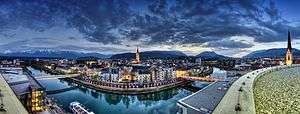 Drava riverside | ||
| ||
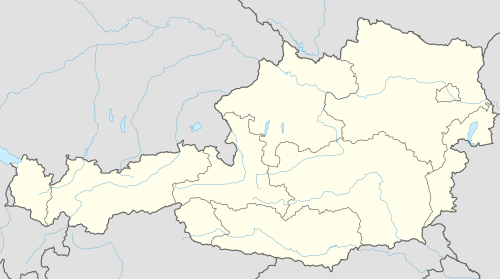 Villach Location within Austria
Location of Villach within Carinthia
| ||
| Coordinates: 46°37′N 13°51′E / 46.617°N 13.850°ECoordinates: 46°37′N 13°51′E / 46.617°N 13.850°E | ||
| Country | Austria | |
| State | Carinthia | |
| District | Statutory city | |
| Government | ||
| • Mayor | Günther Albel (SPÖ) | |
| Area | ||
| • Total | 134.89 km2 (52.08 sq mi) | |
| Elevation | 501 m (1,644 ft) | |
| Population (1 January 2016)[1] | ||
| • Total | 61,221 | |
| • Density | 450/km2 (1,200/sq mi) | |
| Time zone | UTC+1 (CET) | |
| • Summer (DST) | UTC+2 (CEST) | |
| Postal code | 9500 | |
| Area code | 04242 | |
| Vehicle registration | VI | |
| Website | villach.at | |
Villach (German pronunciation: [ˈfɪlax] (![]()
Together with other Alpine towns Villach engages in the Alpine Town of the Year Association for the implementation of the Alpine Convention to achieve sustainable development in the Alpine Arc. In 1997, Villach was the first town to be awarded Alpine Town of the Year.
Geography

Villach, a statutory city, is located on the Drau (Drava) River near the confluence with the Gail tributary. Situated at the western rim of the Klagenfurt basin, the municipal area stretches from the slopes of the Gailtal Alps (Mt. Dobratsch) down to Lake Ossiach in the northeast.
The Villach city limits comprise the following districts and villages:
|
|
In 1905 a part of the municipal area St. Martin was incorporated. In 1973 the city area was further enlarged through the incorporation of Landskron, Maria Gail and Fellach.
Climate
Villach has a cool summer humid continental climate (Köppen Dfb).
| Climate data for Villach 1971-2000 | |||||||||||||
|---|---|---|---|---|---|---|---|---|---|---|---|---|---|
| Month | Jan | Feb | Mar | Apr | May | Jun | Jul | Aug | Sep | Oct | Nov | Dec | Year |
| Average high °C (°F) | 1.4 (34.5) |
5.2 (41.4) |
10.6 (51.1) |
14.9 (58.8) |
20.2 (68.4) |
23.4 (74.1) |
25.6 (78.1) |
25.2 (77.4) |
20.8 (69.4) |
14.5 (58.1) |
6.6 (43.9) |
1.8 (35.2) |
14.2 (57.6) |
| Daily mean °C (°F) | −3.2 (26.2) |
−0.6 (30.9) |
4.0 (39.2) |
8.3 (46.9) |
13.5 (56.3) |
16.7 (62.1) |
18.7 (65.7) |
18.3 (64.9) |
14.1 (57.4) |
8.5 (47.3) |
2.2 (36) |
−2.1 (28.2) |
8.2 (46.8) |
| Average low °C (°F) | −6.4 (20.5) |
−4.6 (23.7) |
−0.8 (30.6) |
3.1 (37.6) |
7.9 (46.2) |
11.1 (52) |
12.9 (55.2) |
12.8 (55) |
9.2 (48.6) |
4.6 (40.3) |
−0.7 (30.7) |
−4.8 (23.4) |
3.7 (38.7) |
| Average precipitation mm (inches) | 46.8 (1.843) |
47.1 (1.854) |
65.5 (2.579) |
83.2 (3.276) |
96.1 (3.783) |
120.5 (4.744) |
133.7 (5.264) |
111.3 (4.382) |
102.3 (4.028) |
105.5 (4.154) |
102.2 (4.024) |
61.2 (2.409) |
1,075.4 (42.339) |
| Mean monthly sunshine hours | 84.4 | 120.3 | 160.6 | 167.7 | 208.4 | 214.3 | 245.2 | 227.2 | 190.3 | 142.0 | 85.9 | 73.2 | 1,919.5 |
| Source: Zamg.ac.at[3] | |||||||||||||
History
The oldest human traces found in Villach date back to the late Neolithic. Many Roman artifacts have been discovered in the city and its vicinity, as it was near an important Roman road (today called Römerweg) leading from Italy into the Noricum province established in 15 BC. At the time, a mansio named Sanctium was probably located at the hot spring in the present-day Warmbad quarter south of the city centre. After the Migration Period and the Slavic settlement of the Eastern Alps about 600 AD, the area became part of the Carantania principality.
When about 740 Prince Boruth enlisted the aid of Duke Odilo of Bavaria against the invading Avars, he had to accept Bavarian overlordship. An 878 deed of donation, issued by the Carolingian ruler Carloman of Bavaria, mentioned a bridge (ad pontem Uillach) near the royal court of Treffen, in what is today Villach. In 979 Emperor Otto II enfeoffed Bishop Albuin of Brixen with the Villach manor. After his death, King Henry II in 1007 ceded the settlement to the newly established Bishopric of Bamberg. The bishops also held the adjacent estates along the strategically important route to Italy up to Pontafel, which they retained until 1759 while the surrounding Carinthian ducal lands passed to the Austrian House of Habsburg in 1335.
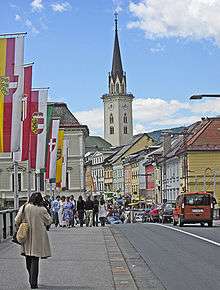
Villach received market rights in 1060, though it was not mentioned as a town in records until about 1240. The parish church dedicated to St. Jacob was first documented in 1136. Emperor Frederick II conferred the citizens the right to hold an annual fair on the feast of 25 July (Jakobitag) in 1222. The 1348 Friuli earthquake devastated large parts of the town, another devastating earthquake occurred in 1690. There were also several fires in Villach, which destroyed many buildings. The first documented mayor took office in the 16th century.
From 1526 onwards, many citizens turned Protestant and the Villach parish became a centre of the new faith within the Carinthian estates, which entailed harsh Counter-Reformation measures by the ecclesiastical rulers. From about 1600, numerous residents were forced to leave the town, precipitating an economic decline. In 1759 the Habsburg empress Maria Theresa formally purchased the Bamberg territories in Carinthia for a price of one million guldens. Villach was incorporated into the "hereditary lands" of the Habsburg Monarchy and became the administrative seat of a Carinthian district.
During the Napoleonic Wars, the city was occupied by French troops and became part of the short-lived Illyrian Provinces from 1809, until it was re-conquered by the forces of the Austrian Empire in 1813 and incorporated into the Austrian Kingdom of Illyria by 1816. The city's economy was decisively promoted by a western branch of the Southern Railway line, which finally reached Villach in 1864, providing growth and expansion. By 1880, the town had a population of 6,104. In World War I, Villach near the Italian front was the seat of the 10th Army command of the Austro-Hungarian Army.
The town obtained statutory city status during the interwar period on 1 January 1932. After the Austrian Anschluss to Nazi Germany in 1938, the mayor of Villach was Oskar Kraus, an enthusiastic Nazi.[4] On 9 November 1938 Villach was a site of the nationwide Kristallnacht pogroms with violent attacks on the Jewish population. A memorial for the 1919 border conflict that led to the Carinthian Plebiscite caused controversy when it was inaugurated in 2002, as Kraus, who had not been especially prominent in the conflict, was the only person named.[5]
During World War II, allied forces bombed Villach 37 times. About 42,500 bombs killed 300 people and damaged 85% of the buildings. Nevertheless, the city quickly recovered.[6] Today, Villach is a bustling city with commerce and recreation, yet it retains its historic background.
Population
| Historical population | ||
|---|---|---|
| Year | Pop. | ±% |
| 1910 | 27,451 | — |
| 1923 | 30,883 | +12.5% |
| 1934 | 34,085 | +10.4% |
| 1939 | 36,012 | +5.7% |
| 1951 | 43,358 | +20.4% |
| 1961 | 47,170 | +8.8% |
| 1971 | 51,112 | +8.4% |
| 1981 | 52,692 | +3.1% |
| 1991 | 54,640 | +3.7% |
| 2001 | 57,497 | +5.2% |
| 2011 | 59,285 | +3.1% |
| 2016 | 61,221 | +3.3% |
Politics
Municipal council
The municipal council (Gemeinderat) consists of 45 members, with the mayor as president, and following the 2015 elections:[7]
- Social Democratic Party of Austria (SPÖ): 23 seats
- Austrian People's Party (ÖVP): 10 seats
- Austrian Green Party: 3 seats
- Freedom Party of Austria (FPÖ): 7 seats
- Verantwortung Erde: 1 seat
- NEOS: 1 seat
City government
The city government of Villach (Stadtsenat) consists of seven members. It is chaired by the mayor, who is directly elected by the people. The other members—two vice-mayors and four town councillors—are appointed by the municipal council, with party affiliations according to the election results.
- Mayor Günther Albel, SPÖ
- First vice-mayor Mag. Dr. Petra Oberrauner, SPÖ
- Second vice-mayor Mag. Gerda Sandriesser, SPÖ
- Councillor Mag. Peter F. Weidinger, ÖVP
- Councillor Erwin Baumann, FPÖ
- Councillor Mag. Harald Sobe, SPÖ
- Councillor Katharina Spanring, ÖVP
In the March 2015 elections, Günther Albel was elected with 55.46 per cent of the votes cast.[8]
| Largest groups of foreign residents[9] | |
| Nationality | Population (2013) |
|---|---|
| 1,549 | |
| 1,421 | |
| 1,238 | |
| 482 | |
| 459 | |
| 364 | |
Twin towns — sister cities
Villach is twinned with:




Festivals
There are several festivals throughout the year:
- The carnival in Villach (which starts on November 11 and ends on March 4)
- The arts and crafts festival (with self made goods)
- Villacher Fasching or Mardi Gras
- The streets-art festival (displays performances of artists and singers)
- The "Villacher Kirchtag" (a festival spanning a whole week in summer and ends on August's first Saturday.)
- Performances on a floating stage on the Drau River
Notable citizens

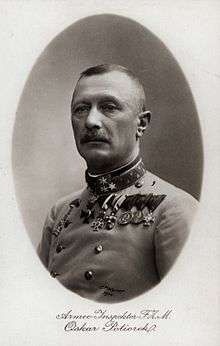
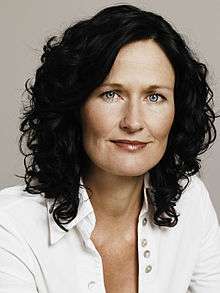
.jpg)

- Anton Janežič, (1828 in St. Jakob im Rosental – 1869) Carinthian Slovene linguist, philologist, author, and literary historian.
- Oskar Potiorek (1853 in Bad Bleiberg – 1933) an officer of the Austro-Hungarian Army, served as Governor of Bosnia and Herzegovina from 1911 until assassinated in Sarajevo in 1914 together with Archduke Franz Ferdinand of Austria
- Anton Ghon (1866 in Villach – 1936) Austrian pathologist viz Ghon focus and Ghon's complex
- Hans Kurath (1891 in Villach – 1992) American linguist of Austrian origin, emigrated to the US in 1907
- Carl-Heinz Birnbacher (1910 in Villach -1991) German naval officer of Austrian origin, Vice admiral of the German Navy
- Albert Bach (1910 in Treffen – 2003) Austrian soldier, Generalmajor, and skier, competed at the 1936 Winter Olympics.
- Hubert Petschnigg (1913 – 1997) Austrian architect, born in Klagenfurt, went to school in Villach.
- Heidemarie Hatheyer (1918 in Villach – 1990) Austrian film actress, appearingd in 43 films between 1938 and 1988
- Paul Watzlawick (1921 in Villach – 2007) Austrian-American therapist, psychologist, communications theorist and philosopher.
- Kurt Diemberger (born 1932), mountaineer and author
- Bruno Gironcoli (1936 in Villach – 2010) Austrian modern artist
- Heidelinde Weis (born 1940) Austrian actress
- Hermann Knoflacher (born 1940 in Villach) Austrian civil engineer.
- Peter Brabeck-Letmathe (born 1944 in Villach), former CEO of the Nestlé Group
- George Zebrowski (born 1945 in Villach) American science fiction author and editor
- Zoltan J. Acs (born 1947 in Villach) American economist and Professor of Management at The London School of Economics
- Felix Tretter (born 1949 in Villach) Austrian psychologist, psychiatrist and cybernetician
- Werner Kofler (1947 in Villach – 2011) Austrian postmodernism novelist
- Gerald Kargl (born 1953 in Villach) Austrian film director most famous for directing the 1983 film Angst
- Wolfgang Ilgenfritz (1957 in Villach – 2013) Austrian politician and notably a non-attached Member of the European Parliament
- Gernot Rumpold (born 1957 in Villach) Austrian politician, associate of Jörg Haider
- Peter Löscher (born 1957 in Villach) Austrian businessman with Merck & Co now CEO of Siemens since 2007
- Eva Glawischnig-Piesczek (born 1969 in Villach) Austrian politician of the Austrian Green Party
- Florian Hufsky (1986 in Villach – 2009) Austrian new media artist, board member of the Pirate Party of Austria
Sport
- Ernst Melchior (1920 in Villach – 1978) Austrian football player for Austria Wien, FC Rouen and FC Nantes
- Hanns Brandstätter (born 1949 in Villach) Austrian fencer. He competed in at the 72, 76, and 1984 Summer Olympics
- Johann "Hans" Lindner (born 1959 in Tragail) hammer thrower 1984 Summer Olympics and bobsledder in 1984 Winter Olympics
- Alfred Groyer (born 1959) Austrian former ski jumper who competed from 1978 to 1984 and in the 1980 Winter Olympics
- Alex Antonitsch (born 1966 in Villach) former tennis player from Austria, turned professional in 1988
- Bärbel Jungmeier (born 1975 in Villach) road cyclist and mountain bike rider competed in the 2004 Summer Olympics
- Gerhard Unterluggauer (born 1976 in Villach) Austrian former professional ice hockey defenceman
- Roland Kollmann (born 1976 in Villach) retired Austrian football for Grazer AK
- Daniel Mesotitsch (born 1976 in Villach) Austrian biathlete
- Friedrich Pinter (born 1978 in Villach) Austrian former biathlete
- Martin Koch (born 1982 in Villach) Austrian former ski jumper.
- Michael Grabner, (born 1987 in Villach) Austrian professional ice hockey player for New York Rangers of National Hockey League
- Marc Sand (born 1988 in Rosegg) Austrian footballer, who plays for SK Austria Klagenfurt.
- Michael Raffl (born 1988 in Villach) Austrian professional ice hockey left winger for Philadelphia Flyers of National Hockey League
- Guido Burgstaller (born 1989 in Villach) Austrian professional footballer who plays as a striker for FC Schalke 04
- Marco Schwarz (born 1995 in Villach) Austrian World Cup alpine ski racer.
References
- ↑ Statistik Austria - Bevölkerung zu Jahresbeginn 2002-2016 nach Gemeinden (Gebietsstand 1.1.2016) for Villach.
- ↑ "Einwohnerzahl und Komponenten der Bevölkerungsentwicklung (Population and Components of Population Growth)" (PDF) (in German). Statistik Österreich (English Version). 2007-11-29. Retrieved 2007-12-27. External link in
|publisher=(help) - ↑ http://www.zamg.ac.at/fix/klima/oe71-00/klima2000/klimadaten_oesterreich_1971_frame1.htm. Missing or empty
|title=(help) - ↑ Lisa Rettl, Werner Koroschitz, "Ein korrekter Nazi: Oskar Kraus, ns-oberbürgermeister von Villach", Drava (2006), ISBN 3-85435-501-7
- ↑ ORF Kärnten, "Oskar Kraus - ein korrekter Nazi" (in German)
- ↑ "Luftkrieg (aerial warfare) "Ostmark"". www.airpower.at (in German). Martin Rosenkranz. 2003-08-13. Retrieved 2007-12-18. External link in
|work=(help) - ↑ http://www.villach.at/stadt-regierung/wahl-service/wahlstatistiken
- ↑ Wahlergebnisse 2015 Archived 2017-02-02 at the Wayback Machine.
- ↑ "Statistisches Jahrbuch 2014". www.villach.at. Stadt Villach - Melde- und Standesamt, Statistik. Retrieved 2015-09-03.
External links
| Wikimedia Commons has media related to Villach. |
| Wikivoyage has a travel guide for Villach. |
- "Municipal data for Villach". Statistik Austria.
- Villach - official web site (English version)
- Kowatsch - Villach Bus System official site
- - official web site of the Carinthia University of Applied Sciences - FH Kärnten

